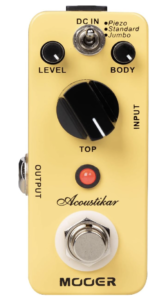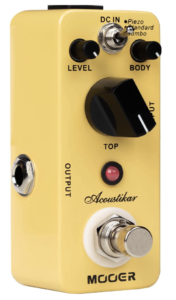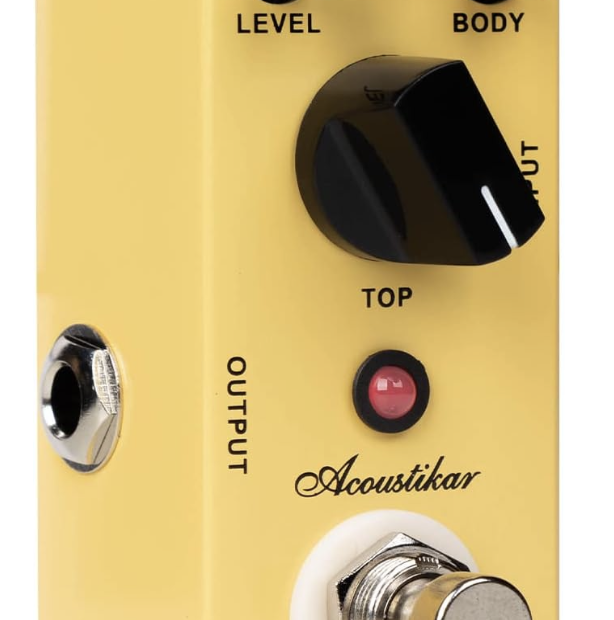the MOOER Acoustikar is an acoustic guitar simulator pedal designed to transform the sound of an electric guitar into that of an acoustic guitar. It’s manufactured by MOOER Audio, a company known for producing compact and versatile guitar effects pedals.
The Acoustikar pedal (buy here) aims to provide guitarists with the ability to achieve acoustic-like tones without having to switch to an actual acoustic guitar. It does so by utilizing digital signal processing to emulate the resonance, timbre, and characteristics of an acoustic guitar sound.
Key features of the MOOER Acoustikar pedal may include:
Three Modes
 The MOOER Acoustikar (buy here) pedal offers three distinct modes that simulate different types of acoustic guitar tones. These modes aim to capture the characteristics of various acoustic guitar body styles and pickup configurations. The three modes are typically:
The MOOER Acoustikar (buy here) pedal offers three distinct modes that simulate different types of acoustic guitar tones. These modes aim to capture the characteristics of various acoustic guitar body styles and pickup configurations. The three modes are typically:
- Standard: This mode is designed to replicate the sound of a standard steel-string acoustic guitar. It aims to capture the warm and balanced tone commonly associated with traditional acoustic guitars.
- Jumbo: The Jumbo mode emulates the sound of a jumbo-sized acoustic guitar. Jumbo guitars are known for their larger body size, which often leads to a more pronounced bass response and a powerful overall sound.
- Piezo: Piezo pickups are commonly used in acoustic-electric guitars to amplify the natural acoustic sound. This mode is likely to simulate the direct and bright tone produced by a piezo pickup, which can often be heard in live performances and recordings of acoustic-electric guitars.
Each mode on the MOOER Acoustikar pedal aims to provide a unique acoustic guitar tonality, allowing electric guitarists to experiment with different sounds and textures without needing an actual acoustic guitar.
Also Read:
Mooer PE100: A Compact Multi-Effects Pedal for Guitarists
MOOER Groove Loop Drum Machine Review
MOOER Micro Drummer II Pedal Review
Mooer E7: Polyphonic Guitar Synth Effects Pedal Review
The 8-String Guitar: Expanding Your Possibilities
Boss GT-1 Guitar Multi-effects Pedal
LAVA ME 3 Carbon Fiber Guitar Review
Blend and Level Controls
The “Blend” and “Level” controls on the MOOER Acoustikar pedal (buy here), like on many other guitar pedals, are used to adjust the balance between the affected (simulated acoustic) signal and the original (dry) signal, as well as control the overall output volume. Here’s how you can use these controls effectively:
- Blend Control:
- The “Blend” control allows you to adjust the mix between the dry (original) guitar signal and the simulated acoustic guitar signal produced by the pedal.
- Turning the knob clockwise increases the intensity of the simulated acoustic sound, gradually blending it with your dry guitar signal.
- Turning the knob counterclockwise reduces the simulated acoustic sound, allowing more of your original guitar tone to come through.
- Level Control:
- The “Level” control adjusts the overall output volume of the pedal.
- Increasing the “Level” knob clockwise will make the pedal’s output signal louder.
- Decreasing the “Level” knob counterclockwise will lower the pedal’s output volume.
 Here’s a step-by-step guide on how to use these controls:
Here’s a step-by-step guide on how to use these controls:
- Setup:
- Connect your electric guitar to the input of the MOOER Acoustikar pedal.
- Connect the output of the pedal to your amplifier, audio interface, or other sound equipment.
- Adjusting the Blend:
- Start with both the “Blend” and “Level” knobs set to the middle (12 o’clock) position.
- Play your guitar and engage the pedal’s effect by pressing the footswitch.
- Gradually turn the “Blend” knob clockwise to introduce the simulated acoustic sound. Find a balance that complements your playing style and the desired tone.
- Setting the Level:
- After adjusting the blend, play your guitar again and pay attention to the overall volume.
- Adjust the “Level” knob to match the output volume to your liking. Ensure that the pedal’s output level matches the bypassed (non-effected) signal level.
- Fine-Tuning:
- Experiment with different settings of the “Blend” control to achieve various degrees of acoustic simulation while maintaining the desired balance with your original tone.
- Use your ears to determine what sounds best for your playing and the specific song or context you’re in.
True Bypass:
 Like many other MOOER pedals, the Acoustikar may feature true bypass switching, which ensures that the pedal’s circuitry doesn’t color your tone when the effect is turned off.
Like many other MOOER pedals, the Acoustikar may feature true bypass switching, which ensures that the pedal’s circuitry doesn’t color your tone when the effect is turned off.
True bypass is a feature commonly found in many guitar pedals, including the MOOER Acoustikar, that allows the pedal’s circuitry to be completely bypassed when the effect is turned off. This helps maintain the integrity of your original guitar signal when the pedal is not in use. Here’s how to effectively use the true bypass feature:
- Engaging the Effect:
- Start with the MOOER Acoustikar pedal (buy here) in its bypassed state, meaning the effect is turned off.
- Play your guitar as you normally would, and you will hear your original, unaltered guitar signal passing through the pedal without any acoustic simulation.
- Activating the Effect:
- When you want to apply the acoustic simulation effect to your guitar signal, press the pedal’s footswitch. This will engage the effect, and you will hear the simulated acoustic tone.
- Disengaging the Effect (True Bypass):
- To return to your original, unaltered guitar signal, simply release the footswitch. This will disengage the effect and activate the true bypass mode.
- In true bypass mode, the pedal’s circuitry is completely bypassed, ensuring that your guitar signal passes through the pedal without any coloration or alteration.
- Using in a Pedal Chain:
- If you’re using multiple pedals in your setup, the true bypass feature helps prevent signal degradation and maintains the quality of your tone.
- Place the MOOER Acoustikar pedal in your pedal chain where you want to apply the acoustic simulation effect.
- When the pedal is turned off (in true bypass mode), your signal will pass through the pedal unaffected, just like if the pedal wasn’t in your chain at all.
It’s important to note that while true bypass is generally designed to preserve your original signal quality, some players may find that using long lengths of cable or multiple true bypass pedals in a chain can potentially lead to high-frequency loss or other signal-related issues. In such cases, using a buffered pedal or a dedicated buffer device may help maintain your signal’s integrity over longer cable runs.
Other Useful Features
- Compact Size: MOOER is known for its compact pedal designs, which are intended to save space on a guitarist’s pedalboard.
- Power Supply: The pedal may be powered using a standard 9V DC power supply.
- Versatility: Acoustic simulator pedals can be particularly useful for live performances, studio recordings, and creative experimentation, as they allow guitarists to explore different sonic textures without needing an actual acoustic guitar.
